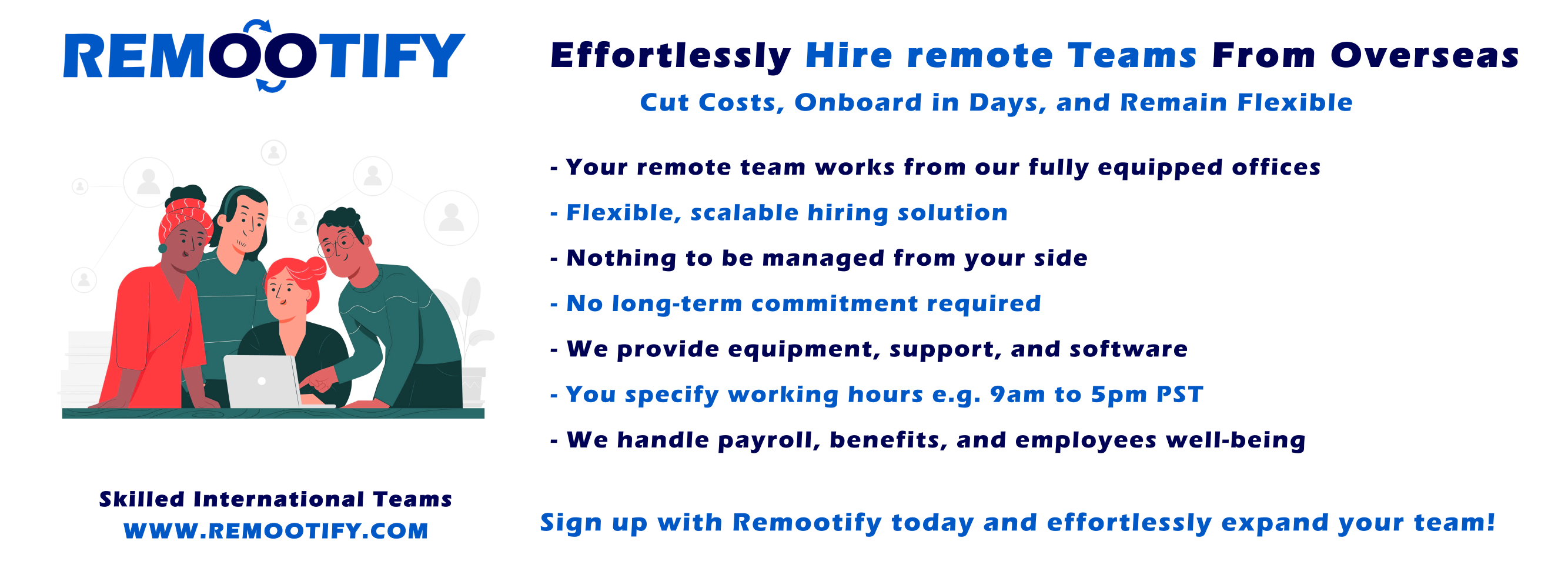Start hiring YOUR REMOTE TEAM, Today!
Enter your information below to start a discussion with one of our team members!

Onboarding international employees is crucial for organizations operating in a globalized world. As the workforce becomes increasingly diverse, hiring global talent offers numerous advantages. However, integrating international employees into the workplace seamlessly requires careful planning and execution. In this guide, we will explore the best practices and strategies to ensure a smooth transition for international employees, maximizing their productivity and fostering a positive work environment.
Why Onboarding International Employees Matters?
A Global Perspective
Expanding your talent pool globally brings diverse perspectives, unique skill sets, and cultural insights to your organization. Embracing diversity allows companies to foster innovation and creativity, providing a competitive edge in today’s global marketplace. Thus, onboarding international employees can be highly beneficial for your business.
Retention and Engagement
Properly onboarding international employees significantly impacts their retention and engagement levels. A well-structured onboarding process enhances job satisfaction, builds loyalty, and increases the likelihood of long-term commitment. By investing in their successful integration, organizations can reduce turnover rates and retain top talent.
Onboarding International Employees: The Key Elements
1- Pre-arrival Preparation
This is the first element of the process of onboarding international employees. Before an international employee arrives, establish clear communication and provide necessary resources. Share information about company culture, policies, and expectations. Offering support for visa applications, travel arrangements, and accommodation can alleviate stress and ensure a smooth transition.
2- Cultural Orientation
Understanding and appreciating different cultures is fundamental to effective onboarding. Organize cultural orientation sessions to help international employees acclimate to their new work environment, anticipate potential challenges, and embrace the diversity within the organization. Promoting cultural sensitivity fosters an inclusive and collaborative workplace.
3- Language Support
Language barriers can hinder effective communication and productivity. Provide language support, such as language classes or resources, to facilitate smoother interactions and build stronger relationships. Effective communication fosters teamwork, innovation, and a sense of belonging for international employees.
4- Buddy or Mentor Programs
Assigning a buddy or mentor to international employees enhances their onboarding experience. Buddies can offer guidance, support, and insider knowledge, helping new employees navigate the organization’s dynamics and culture. This connection fosters camaraderie, boosts confidence, and accelerates the integration process.
5- Cross-Cultural Training
Comprehensive cross-cultural training further supports international employees in adapting to their new work environment. This training includes information about local customs, business etiquette, and communication styles. Equipping employees with this knowledge helps them navigate potential cultural pitfalls and foster effective collaborations.
6- Intercultural Team Building
Promoting intercultural team-building activities creates opportunities for international employees to connect with their colleagues on a personal level. These activities can include team-building exercises, group projects, or social events that encourage interaction and collaboration. By fostering relationships and building a sense of camaraderie, these activities contribute to a positive work environment.
7- Comprehensive Orientation
Providing a comprehensive orientation program goes beyond introducing international employees to their immediate team and work responsibilities. It should also include an overview of the organization’s structure, values, and long-term goals. This broader understanding helps international employees align their work with the organization’s objectives and feel a sense of purpose within their roles.
8- Mentoring and Coaching
In addition to buddy programs, offer mentoring and coaching opportunities for international employees. This can involve pairing them with experienced professionals who can provide guidance and support as they navigate their new roles and the organization. Mentoring and coaching relationships facilitate knowledge transfer, skill development, and professional growth.
9- Cultural Integration Activities
Organize cultural integration activities that allow international employees to share their own culture and traditions with colleagues. This can involve hosting cultural events, international food festivals, or diversity celebration days. Encouraging open dialogue and cultural exchange fosters mutual understanding, respect, and appreciation within the workplace.
Overcoming Common Challenges
Legal and Administrative Considerations
Navigating legal and administrative procedures is often daunting when onboarding international employees. Ensure compliance with immigration laws, work permits, and tax requirements by collaborating with experts in immigration law and HR professionals.
Emotional Support
Relocating to a new country can be emotionally overwhelming for international employees. Feelings of homesickness, cultural shock, and isolation can hinder their integration into the workplace. Offer emotional support through counseling services, employee resource groups, or community engagement initiatives to promote well-being and enhance employee satisfaction.
Building Social Connections
Creating opportunities for social interactions and team building is essential for fostering a sense of belonging. Encourage participation in team activities, social events, and cultural celebrations to help international employees connect with colleagues, build relationships, and establish a strong support network within the organization.
Ongoing Support and Feedback
Onboarding international employees should not end after the initial orientation phase. Providing ongoing support and feedback is crucial to the long-term success of international employees. Regular check-ins, performance evaluations, and career development opportunities demonstrate the organization’s commitment to its growth and ensure its integration remains a priority.
Diversity and Inclusion Initiatives
To create an inclusive work environment, implement diversity and inclusion initiatives that support international employees. Foster a culture of respect and acceptance, celebrate cultural diversity through events and recognition programs, and provide equal opportunities for career advancement.
Technology and Tools
Leverage technology and tools to streamline communication and collaboration among international employees. Utilize video conferencing, project management software, and online collaboration platforms to facilitate virtual meetings, document sharing, and teamwork. Ensuring access to necessary tools and resources empowers international employees to contribute effectively.
Knowledge Sharing and Training
After onboarding international employees, you should encourage knowledge sharing and provide training opportunities to them. Facilitate the exchange of expertise and best practices among team members, both locally and globally. This fosters continuous learning, and professional development, and strengthens the organization’s collective knowledge.
Employee Engagement Surveys
Conduct regular employee engagement surveys to gather feedback from international employees. This feedback can help identify areas for improvement in the onboarding process and provide insights into their overall experience within the organization. Taking action based on survey results demonstrates the organization’s commitment to listening and addressing concerns.
—
Conclusion
Effectively onboarding international employees is vital for organizations seeking to thrive in a globalized world. By implementing the strategies outlined in this guide, companies can create an inclusive and supportive environment that enables international employees to excel. Remember, successful onboarding goes beyond paperwork and logistics; it embraces cultural understanding, communication, ongoing support, leveraging technology, and fostering employee engagement. Embracing the diversity and talent that international employees bring will undoubtedly contribute to the success of your organization. So, take the necessary steps to ensure a smooth transition and reap the rewards of a global workforce.
—
FAQS
Why is onboarding international employees important for organizations operating in a globalized world?
Onboarding international employees is crucial because it expands the talent pool globally, bringing diverse perspectives, unique skill sets, and cultural insights to the organization. Embracing diversity allows companies to foster innovation, creativity, and gain a competitive edge in the global marketplace.
How does properly onboarding international employees impact their retention and engagement levels?
A well-structured onboarding of international employees process enhances job satisfaction, builds loyalty, and increases the likelihood of long-term commitment from international employees. By investing in their successful integration, organizations can reduce turnover rates and retain top talent.
What are the key elements of successfully onboarding international employees?
The key elements of successful onboarding international employees include pre-arrival preparation with clear communication and necessary resources, cultural orientation sessions to help them acclimate, language support, buddy or mentor programs for guidance, comprehensive orientation covering company values and goals, cross-cultural training, intercultural team-building activities, and opportunities for mentoring and coaching.
How can organizations foster social connections for international employees within the workplace?
Organizations can foster social connections for international employees by encouraging participation in team activities, social events, and cultural celebrations. These opportunities allow international employees to connect with colleagues, build relationships, and establish a strong support network within the organization.
What emotional support should be provided to international employees during their relocation?
Relocating to a new country can be emotionally overwhelming for international employees. To provide emotional support, organizations can offer counseling services, establish employee resource groups, or engage in community initiatives to promote well-being and enhance employee satisfaction.
Why are employee engagement surveys important in the onboarding process for international employees?
Employee engagement surveys allow organizations to gather feedback from international employees, identifying areas for improvement in the onboarding process and gaining insights into their overall experience within the organization. Taking action based on survey results demonstrates the organization’s commitment to listening and addressing concerns, fostering a positive work environment for international employees.





